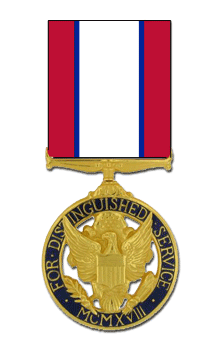 Establishing Authority
Establishing Authority
The Army Distinguished Service Medal was established at the direction of President Woodrow Wilson by War Department General Orders Number 6 of January 12, 1918, and confirmed (with minor modifications) by Act of Congress on July 9, 1918 (Public Law 193, 65th Congress).
Effective Dates
The Army Distinguished Service Medal has been in effect since April 6, 1917. Under certain circumstances the Army Distinguished Service Medal may also be awarded for services rendered prior to April 6, 1917.
Criteria
The Army Distinguished Service Medal may be awarded to any person who, while serving in any capacity with the United States Army, performs exceptionally meritorious service in a duty of great responsibility. The individual's performance must merit recognition for services which are clearly exceptional, and the performance of normal duties in an exceptional manner by itself will not justify an award of the Army Distinguished Service Medal.
Order of Precedence
The Army Distinguished Service Medal is worn after the Defense Distinguished Service Medal and before the Silver Star.
Devices
Additional awards of the Army Distinguished Service Medal are denoted by oak leaf clusters.
Designer and Sculptor
The Army Distinguished Service Medal was designed by Captain Aymar E. Embury, III and sculpted by Private Gaetano Cecere.
First Recipients
The first Army Distinguished Service Medals were presented on October 21, 1918, to the following officers:
- Marshall of France, Ferdinand Foch, Commander-in-Chief of the Allied Armies;
- Marshall of France, Joseph Joffre, the victor of the first battle of the Marne;
- Field Marshall Sir Douglas Haig, Commander-in-Chief of the British Armies in France;
- Marshal of France, Henri Petain, Commander-in-Chief of the French Armies of the North and Northeast;
- Lieutenant General Armando Diaz, Commander-in-Chief of the Italian Armies;
- Lieutenant General C.C.V. Gillain, Chief of the General Staff of the Belgian Army; and
- General John J. Pershing, Commanding General, American Expeditionary Forces.
Descriiption and Symbolism
Obverse
In the center of a medallion one and a half inches in diameter, the coat of arms of the United States surrounded by a circle of dark blue enamel bearing the inscription, FOR DISTINGUISHED SERVICE MCMXVIII. The coat of arms of the United States is also used as the hat insignia by Army officers and therefore represents the United States in general and the Army in particular.
The eagle represents the bald eagle and symbolizes the United States. The five-pointed stars are taken from the United States flag and refer collectively to the United States, just as the inscription on the scroll refers to the fact that the United States is one nation composed of many states. The oak leaves stand for strength and courage. The inscription on the scroll is taken from the Great Seal of the United States and refers to the United States as one nation composed of many peoples.
Reverse
A blank scroll upon a trophy of flags and arms.
Ribbon
The ribbon consists of a central stripe of white edged with blue pinstripes and an outer band of red. The colors of the flag, they and are arranged in a configuration to keep this ribbon from being confused with others using the same color combination.